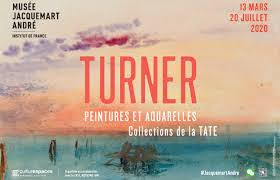
Figure 1. Turner Exhibition at the Jacquemart-Andre Museum
As any of you who read my review of the George A Lucas collection last week know, I hate too much of anything - Peales, prints, pants (but especially Renoirs). I feel the same about Turner, yes, that Turner, JMW Turner, the great 19th century English artist whose watercolors and paintings presaged Impressionism. And I was really worried that this exhibition might be a kitchen sink kind of affair because it is being held in conjunction with the Tate Britain which just happens to have the largest collection of Turners in the world. The guy never threw anything out, period. I was at the Andy Warhol museum a couple of years ago and he was the same. Apparently at the end of every day, Warhol just slid everything that was on his desk into that week’s box. There are walls of those boxes at that museum. Ditto for Turner, but his, sometimes moldy, sometimes brilliant detritus is part of that huge collection of Turner ‘stuff’ at the Tate Britain. Also, as those of you who read an earlier post might remember, I intended to let you wander through ‘virtual museum tours’ unguided because well, what’s the point. And here I am, about to review an exhibition that you will only be able to see virtually. The Turner exhibition at the Jacquemart-Andre museum opened on March 13, and I said to myself, relax, you can see it next week. Turns out I couldn’t, because everything came crashing down, by which I mean iron gates and wooden doors, barring entry. By the next Monday, 17 March, it was too late. Today, 19 May, our deconfinement in Paris is one week old. But so far, there's nowhere to go? The museums are still closed, ditto for cafes and bistros. The metros seem the wrong gamble to make right now, so an exhibition available virtually is virtually our only option.
Reminiscing about the past, do you remember when I reviewed the Cezanne exhibition at the Monet Marmottan ? It was the last actual exhibition I was able to review before the confinement, it was, well is (the banner is still up outside the museum) a little show that had a some points to make - the influence ON Cezanne OF 16th century Italian artists and the influence OF Cezanne ON 19th century Italian artists. Paintings were selected to make their points and they did. The Turner exhibition which you can now see virtually at the Jacquemart-Andre is similarly intended. It is a small exhibition, 60 watercolors and 10 oils, spread over eight themes. And while Turner is always credited with having anticipated Impressionism, as this exhibition shows, he was a man of his time. A strange man, but a man of his time nonetheless. And it wasn’t as if all of his impressionistic watercolors had any influence on the impressionists, those watercolors were buried at the bottom of cartons, awaiting discovery.
This exhibition is about Turner the artist and not about Turner the man, which is just as well since he was definitely on the spectrum, as we say these days. His mother exhibited signs of mental illness from the time Turner was 10 years old and when she was finally admitted into an institution for the mentally ill, he was 24. That same year, 1799, his father who had made his living as a barber, moved in with Turner and lived with him for the next 30 years. Turner never married but did father two daughters by his long suffering housekeeper, or those girls may have been fathered by his father, or maybe, no, let’s not go there. The film ‘Mr Turner,’ which was released in 2014 to some acclaim, portrays Turner as the eccentric curmudgeon he was acknowledged to be. See the film, you probably have the time now.
The medium most associated with Turner is watercolor. It is a technique that is often not given much respect, dismissed as suitable for professional artists’ sketches and for amateur hobbyists’ efforts. I used to give tours at a paper mill, a moulin, in the south of France, that made watercolor paper by hand. Watercolor paper is cotton based. The cotton used where I worked was unused scraps from Lacoste shirts. The paper was beautiful, it was expensive, it was often made to order. For the people who came to the moulin for a tour, there were notecards and bookmarks for sale and ‘carnets de voyage’ little bound books with a tiny traveling brush and tiny dabs of watercolor paints. Amongst the cartons Turner left to the British nation were his sketchbooks and carnets de voyage. These private and experimental works were made, according to the writer John Ruskin, for Turner’s ‘own pleasure and delight.’
As you will see, the exhibition at the Musée Jacquemart-André includes examples of Turner’s private and experimental works alongside paintings intended for sale, By juxtaposing watercolors with oil paintings, sketches with finished works, the exhibition offers the visitor a glimpse at how Turner worked, at how the informal and private informed the finished and public. Divided into eight sections, each has a point to make and a few well chosen watercolors and oil paintings to illustrate them. I will tell you about a few and then let you explore those and others on your own, virtually.
Section One will be a surprise for most Turner fans since his earliest surviving sketches, when still a preteen, are architectural studies and exercises in perspective rather than the celebrations of light and color which we associate with him. At fourteen, Turner began taking classes in perspective and topography at the Royal Academy of Art, useful choices for a young lad earning his keep as an architect’s draftsman. As soon as he could, Turner began traveling during the summer months, sketchbook in hand. Turner was no pleine air artist. He sketched outdoors and painted indoors. Where did he go on his earliest annual peregrinations? Well, England’s empire may have spanned the globe, but war with France meant that the Continent was off limits so he traveled around England from Wales to the Scottish Highlands.
Section Two begins with a trip Turner took to the Swiss Alps (Figure 2) and Paris, to the Louvre, to study the Old Masters.The Treaty of Amiens (1802-03) between England and France made that trip possible but Turner had to wait another 15 years, until the defeat of Napoleon at Waterloo, before he could travel to the Continent again. He concentrated instead on his Liber Studiorum (‘Book of Studies’) based on his watercolor designs which demonstrate categories of landscape ranging from the natural to the ideal. (Figure 3) Turner created his book as a way to promote himself as a worthy descendant of Claude Lorrain. Have you heard of Claude Lorrain, the 17th century French painter of landscapes who spent most of his life in Italy and whose picturesque paintings were all the rage in England when Turner was a young man? (Figure 4) In fact, a fan of Claude’s invented a Claude glass so that Claude loving English aristocrats could roam the countryside looking for views, in nature, that resembled the Claude canvases they loved. (Figure 5) Of course no such views existed, that is why God created artists. But these Englishmen had their trusty Claude glass to perform the miracle. To use the mirror, travelers would come upon a scene and tell their coachman to halt. Then they would turn their backs to the scene. Holding the mirror at shoulder height and angling it so they could see behind them, the mirror performed its miracle. The convex shape of the mirror made distant objects look farther away and the mirror’s tinted glass softened the reflected tones. I read an article on selfies recently, as one does. The author posits that the Claude glass is a precursor of the selfie, minus the self but definitely looking away from the view and into the camera with filters to make it art !
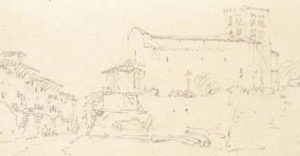
Figure 2. Turner, Swiss Alps, 1802
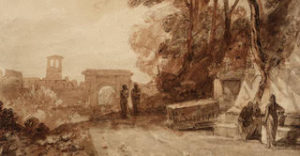
Figure 3. Turner. Liber Studiorum, 1807-19
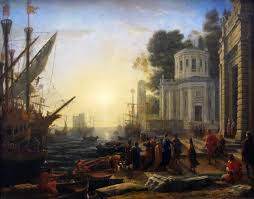
Figure 4, Claude Lorrain, Cleopatra at Tarsus, 1642
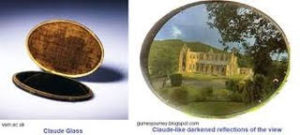
Figure 5, Claude glass and reflection
While the Turner we know and admire seems the antithesis of what can be achieved with a Claude glass, a link between Turner and a contemporary artist, Philip de Loutherbourg, seems more obvious. Loutherbourg’s Eidophusikon was a miniature theatre based on the stage set designs Loutherbourg had created. For the Eidophusikon, Loutherbourg used transparent colored lantern slides, to create the illusions of green trees turning russet and the moon rising and lighting the edges of passing clouds. (Figure 6) Loutherbourg took his Eidophusikon to a party at William Beckford’s mansion, Fonthill Abbey in 1781. Nearly twenty years later, Beckford invited Turner to his fantastical mansion to paint views. (Figure 7)
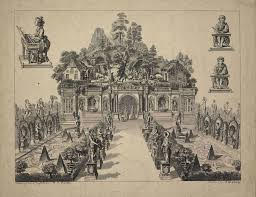
Figure 6, Loutherbourg, Eidophusikon
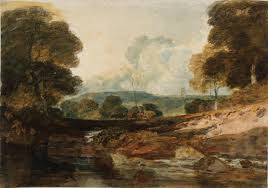
Figure 7, Turner, Fonthill Abbey, 1799
Sections Three and Four concentrate on Turner’s travels which didn’t really begin in earnest until 1819 with his first of his Grand Tours of the Continent. In 1819, Turner was in Italy for six months, mainly in Rome, studying classical monuments. He squeezed in two side trips, one to Naples, another to Venice. The intensity of light in southern Italy made a lasting impression on the artist who was already changing the way he depicted light and color.
Turner travelled through France too, bien sûr, along the Rivers Seine and Loire. He made pencil outlines on site which he later transformed into watercolors and gouache on tinted paper. Engravings followed and these were sold as travel books. Turner’s pattern was to travel and sketch during the summer, work on and finish up in the winter. Repeat. Have you heard of limners, male (mostly), artists (maybe) who traveled the countryside during the summer months, sketching likenesses and making notes on the people whose portraits they would paint during the winter. The following summer, they would once again travel around the countryside, looking for work, bringing finished portraits of the visages they had sketched the summer before. Sometimes their notes were less than accurate and a person would be flattered to find their face on a thinner body, other sitters not so pleased, finding themselves more corpulent than they were, or imagined they were. Of course likeness was not a goal for Turner, the wilder and more imaginative he could make his scenes, the more they were appreciated.
Sections Seven and Eight celebrate the last decades of Turner’s life, during which he painted some of his finest watercolors. Two events came together to permit Turner to become ‘Turner’ - his clientele changed and so did taste. His work was sought after by a small group of connoisseurs and admirers which freed Turner from having to produce for exhibitions or publishers. And he took a third and final trip to Venice in 1840, from which he produced a wealth of watercolors and a collection of canvases. La Serenissima - magical light, shimmering reflections off the lagoon, dissolving phantom-like architectural forms. One of the oil paintings from this period prompted a critic to proclaim Turner a ‘magician’, with ‘command over the spirits of Earth, Air, Fire and Water’. (Figure 8)
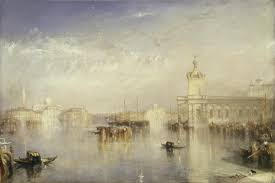
Figure 8, Turner, Venice, 1834
I have been rereading John Berger’s, About Looking (1980). Here is a snippet of his thoughts on Turner, the son of a barber who lived during the Industrial Revolution. “Consider,” writes Berger, “some of his later paintings and imagine, in the backstreet shop, water, froth, steam, gleaming metal, clouded mirrors, white bowls or basins in which soapy liquid is agitated by the barber’s brush and detritus deposited. Consider the equivalence between his father’s razor and the palette knife which Turner insisted upon using so extensively. More profoundly - at the level of childish phantasmagoria - picture the always possible combination, suggested by a barber’s shop, of blood and water, water and blood.” Berger continues, “Turner lived through the first apocalyptic phase of the British industrial revolution. Steam meant more than what filled a barber’s shop. Vermilion meant furnaces as well as blood. Wind whistled through valves as well as over the Alps.” Wow! (Figure 9)
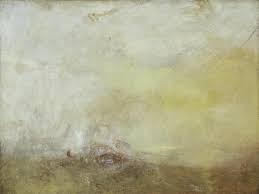
Figure 9, Turner, 1845
Turner’s childhood memories and the Industrial Revolution. Claude Lorrain and the Eidophusikon. None could predict the artist Turner would become but they can give us some insights into the multiple strains of his genius. So, now enjoy your trip to the virtual exhibition of Turner’s work at the Jacquemart-Andre Museum.
NEWS FLASH. Small museums are beginning to open up here in Paris, including the Jacquemart-Andre sometime in June. I’ll keep you posted.

2 comments
Franny Hurwitz May 19, 2020
Excellent in depth review once again by Dr B ! Full of insight , knowledge and of course that wit ! Holding g my breath for the next !
Sharon May 22, 2020
Having dipped into the Tate Britain many times during a one year sojourn in London, I agree that there is such a thing as too much Turner. Nevertheless, your interesting review makes me want to check this one out. Could you please coach me on how to access the virtual exhibition?